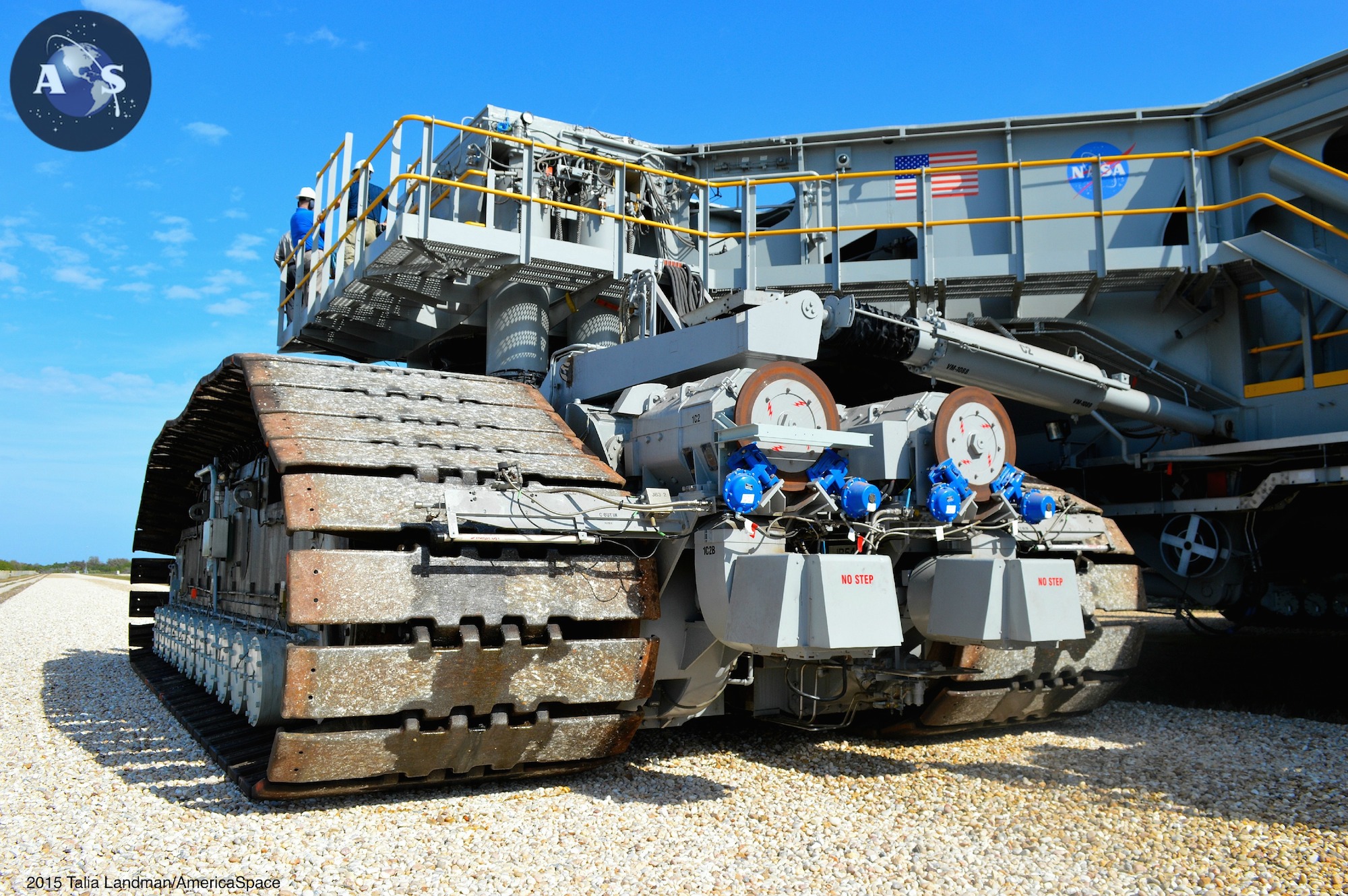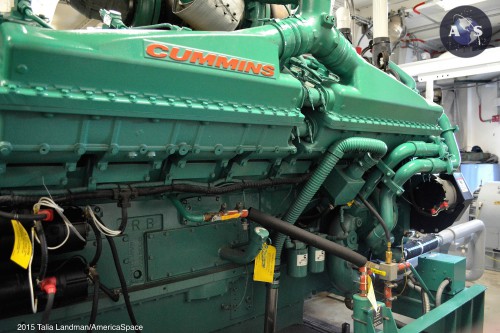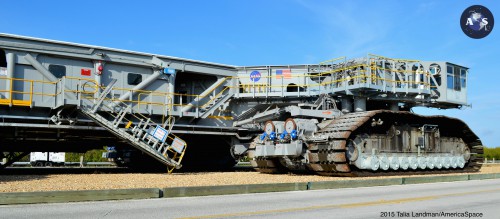
NASA’s massive Crawler Transporter-2, also known as CT-2, was moved on Monday, Feb. 23, to the Kennedy Space Center (KSC) to test the completed modifications that will allow it to transport NASA’s next heavy-lift rocket and Orion capsule for manned trips to space. This marks 50 years since the iconic crawler became an integral part of the agency’s manned space program.
Back-dropped by the massive 113-foot-long and 114-foot-wide CT-2, NASA crawler project manager Mary Hanna explained some of the history behind the iconic crawler and described the changes made to modify it for NASA’s next generation spacecraft, Orion, and heavy-lift rocket, the Space Launch System.
“The crawler concept started back in the early 1963. Marion Power Shovel out in Ohio got commissioned to start building the crawler […], and later on around late 1964 they brought it out here to Merritt Island to finish the completion of the construction. The first time the crawler powered on its own was January, 23, 1965.”

It has been 50 years since the two crawler-transporters began working at NASA’s Kennedy Space Center, carrying the Saturn V moon rocket and Apollo spacecraft from the Vehicle Assembly Building (VAB) to the launch pad. After Apollo, the crawlers, CT-1 and CT-2, continued to work throughout the space shuttle program, transporting the space shuttles to their launch pads for the entire 30-year program.
“After the end of the shuttle program the crawler was selected to continue to carry the legacy of the space program. So we took it down 3 years ago and looked at the entire crawler knowing that SLS is heavier than the shuttle program. The shuttle weighed about a little over 12 million lbs. with the mobile launch platform.”
The modifications to CT-2 will allow the vehicle to transport an increased lifted-load capacity up to 18 million lbs. Right now, SLS is expected to weigh in at a little over 14 million lbs. (with the mobile launcher). Some of the modifications tested were the 88 traction roller bearings, which provide additional structural support for the crawler, jacking, equalization, and leveling (JEL) cylinders that allow the crawler to remain stable when going up on an incline to the launch pad, as well as the increased capability for power. Previously there were two 700 kw generators inside the crawler to help power it up. Now there are two 1500 kw generators, in addition to the two locomotive 2750 hp motors to propel the crawler down the crawler way.
Other modifications include replacing old electronics, cables, tubing, and hydraulic components. The fuel tanks and hydraulic systems were cleaned as well to extend the lifetime of the systems that help the crawler function. A modified lubrication delivery system sprays grease in between the shoes as CT-2 goes down the crawler way, and there is a temperature monitoring system with 352 new thermocouples. There are 16 sets of gear boxes on CT-2 with only two undergoing tests on this day. The remaining 14 will be tested on a later date.
“We are almost done. We got a little over a year left before we call it completely done,” Hanna said.
All that is left is, “finishing the rest of the gear boxes and replacing those JEL cylinders,” Hanna added. “They are here in storage and when we go back into the VAB that is what we’re going to be doing- replacing those JEL cylinders and upgrading the rest of the 14 sets of gear boxes.”

In a previous AmericaSpace article, it was noted that both CT-1 and CT-2 traveled along the 130-foot-wide gravel path between the VAB and Launch Complex 39 hauling “skyscraper-size” Saturn V rockets and space shuttles. They traveled three to four miles to LC-39A or LC-39B carrying nearly 12 million lbs. of expensive spacecraft. Topping out at a speed no faster than 2 mph unloaded (~1 mph loaded), CT-1 and CT-2 take the honor of being known as the largest self-propelled land vehicles in the world. The journey from VAB to launch pad took nearly 6 hours to complete. The next time CT-2 carries cargo to LC-39, the entire SLS/Crawler vehicle will weigh 18 million lbs.
“All the design, all functionality of the crawler, all pick-up points that mates to the mobile launcher still is the same,” said Hanna. Though the crawler is modified to carry 6 million more pounds of weight and upgraded with newer equipment it still function the same way. Hanna noted that there aren’t any big changes to the crawler in terms of how it is used. They replaced what was outdated with more modern materials to ensure the crawler’s longevity for at least another 50 years. “Twenty to twenty-five percent of the system has been updated and upgraded, but not replaced with something completely different.”

The Ground Systems Development and Operations Program (GSDO) at KSC is working hard to get CT-2 ready for the next era of human spaceflight. This test marked a very important milestone for the team as they prepare the crawler for SLS.
During its test, CT-2 rode along crawler way up to Pad 39B at a speed around 0.7 mph. Don’t let those slow speeds fool you, though; it’s a pretty big gas-guzzler. The crawler gets 42 feet per gallon and uses up 125.7 gallons per mile. It is three stories tall and weighs about 6 million lbs. A team of about 12 engineers is needed to monitor the crawler as it literally crawls from the VAB to launch pad. It has 456 tred-belt shoes with each shoe weighing one ton and measuring 7.5 feet long by 1.5 feet wide.
NASA plans to send astronauts back into space from American soil to explore the depths of our Solar System. Manned missions to Mars, an asteroid, and beyond are in the future for NASA, and the completion of CT-2 puts the agency one step closer. The SLS rocket with Orion will be ready to launch by 2018, and CT-2 will be responsible for moving the massive heavy-lift rocket with spacecraft from the VAB to LC-39B.
Want to keep up-to-date with all things space? Be sure to “Like” AmericaSpace on Facebook and follow us on Twitter: @AmericaSpace
Missions » SLS » EM-1 »




You might want to check your facts in regards to the power systems on board the CT. There are two 2750hp diesel engines driving 4 – 1000Kw generators that power 16 – 375hp electric motors (2 each track, 4 each truck) that actually provide the motive force of moving the CT (the CT actually moves via electricity, just like a locomotive – NOT diesel). The smaller engines/generators power the JEL system and other ancillary items. This is a good link:
http://www.nasa.gov/sites/default/files/638823main_crawler-transporter.pdf
Also, you’ve got the speeds reversed – the UNloaded speed is 2mph and the LOADED speed is 1mph.
FYI.
A very different kind of heavy lift.